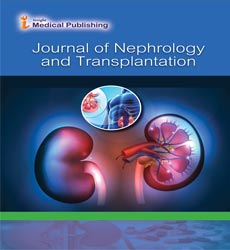Causes and Prognosis by Urinary Tract infections
Michel Dashbazar*
Department of Medicine, University of Kashihara, Sousse, Indonesia
- *Corresponding Author:
- Michel Dashbazar
Department of Medicine, University of Kashihara, Sousse,
Indonesia;
E-mail: Micheldashbazar@gmail.com
Received: February 18, 2022, Manuscript No. IPNT-22-11515; Editor assigned: February 21, 2022, PreQC No.IPNT-22-11515 (PQ); Reviewed: March 07, 2022, QC No. IPNT-22-11515; Revised: March 11, 2022, Manuscript No. IPNT-22-11515 (R); Published: March 18, 2022, Invoice No. IPNT-22-11515
Citation: Dashbazar M (2022) Causes and Prognosis by Urinary Tract Infections. J Nephrol Transplant Vol:6 No:1
Editorial
Urinary tract infections are infections of the urinary system, kidneys, ureters, bladder, and any part of the urethra. Most infections effect on the lower urinary tract. Women are at greater risk of developing urinary tract infections than men. Infections limited to the bladder can be painful and annoying. However, if a urinary tract infection spreads to the kidneys, it can have serious consequences. Antibiotics are a typical treatment for urinary tract infections. However, there are steps you can take to reduce your chances of getting a urinary tract infection in the first place. Antibiotics are an important part of the treatment of urinary tract infections.
Another risk factor for urinary tract infections is a condition that can impede urine flow (i.e. benign prostatic hyperplasia, congenital urinary tract abnormalities, and inflammation). Patients using catheters, undergoing urinary surgery and men with benign prostatic hyperplasia are at increased risk of urinary tract infections. Symptoms and signs of urinary tract infections vary slightly depending on gender, age, and area of the infected urinary tract; depending on the infectious agent, some unique symptoms occur. Urinary tract infections are usually diagnosed by isolating and identifying urinary pathogens in patients. There are several house tests available for suspicious diagnosis. There are home remedies for urinary tract infections, but most of them help in reducing the risk and discomfort of urinary tract infections at best. They are not considered a cure for the disease. Many complications of urinary tract infections can occur, including dehydration, sepsis, renal failure, and death. With early and appropriate treatment, the prognosis for most patients with urinary tract infections is good. There is no urinary tract infection vaccine, but there are many ways to reduce your chances of getting a urinary tract infection. Urinary Tract Infection (UTI): UTI is a bacterial infection of the urinary tract.. Infections occur when bacteria from the rectal area pass through the urethra, enter the bladder and urinary tract, and multiply in the urine. Bacteria often move to the urethra first. Infections can occur when bacteria multiply. An infection that is localized to the urethra is known as urethritis. When bacteria migrate to the bladder and multiply, they cause cystitis, called a bladder infection. If the infection is not treated immediately, the bacteria can travel further up the ureter and multiply in a process known as pyelonephritis, infecting the kidneys.
Technically, these are not urinary tract infections and are briefly mentioned in this article. Urinary tract infections are common and are seen by 7 to 10 million doctors annually. Some infections are overlooked, but urinary tract infections can cause problems ranging from dysuria (pain and burning sensation when urinating) to organ damage and even death. The kidney is an active organ that produces about 1.5 liters of urine per day. They balance electrolytes and liquids (e.g. potassium, sodium, water), remove waste products (urea), and help produce hormones that help make red blood cells. If the kidneys are damaged or destroyed by an infection, these important functions can be damaged or lost.
There is a general consensus that sexual intercourse can cause urinary tract infections. This is primarily considered a mechanical process by which bacteria are introduced into the urinary tract during sexual intercourse. There is no controversy over the transmission of urinary tract infections caused by Sexually Transmitted Diseases (STDs). These infections (e.g. gonorrhea and chlamydia) are easily transmitted between sexual partners and are highly contagious. Some of the symptoms of UTI and STI may be similar (pain and foul odor). Urinary tract infections, or UTIs, are infections that can occur anywhere along the urinary tract. Urinary tract infections have different names depending on which part of the urinary tract is affected.
Open Access Journals
- Aquaculture & Veterinary Science
- Chemistry & Chemical Sciences
- Clinical Sciences
- Engineering
- General Science
- Genetics & Molecular Biology
- Health Care & Nursing
- Immunology & Microbiology
- Materials Science
- Mathematics & Physics
- Medical Sciences
- Neurology & Psychiatry
- Oncology & Cancer Science
- Pharmaceutical Sciences
